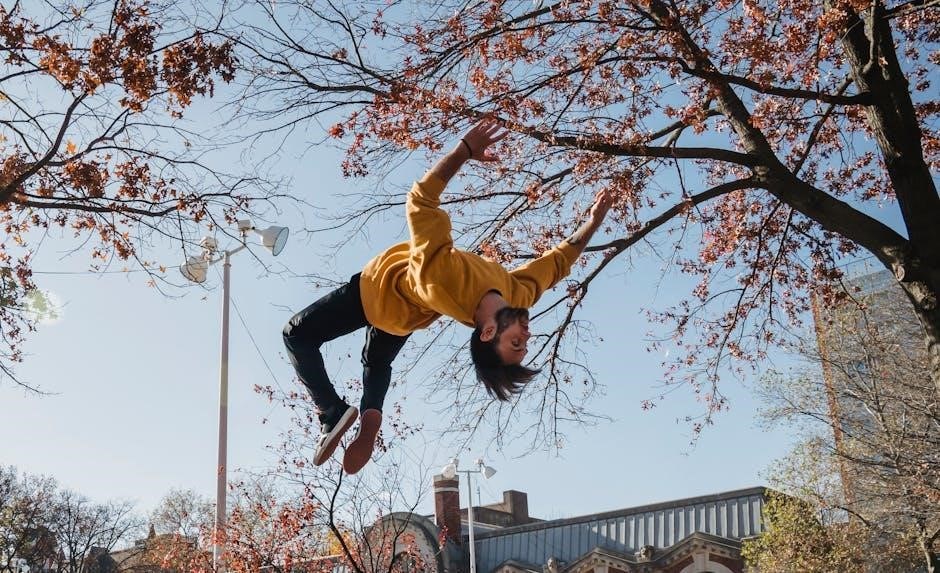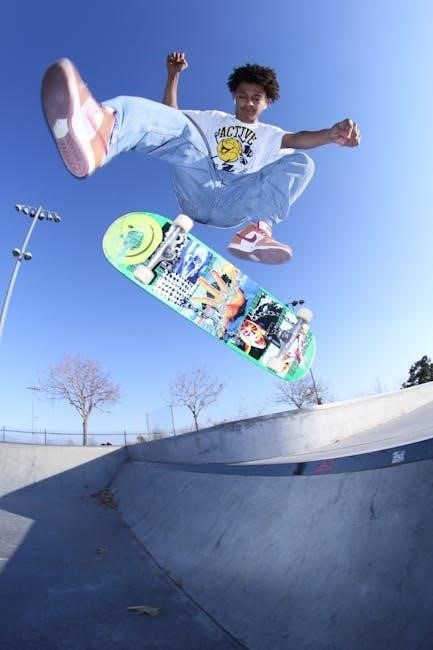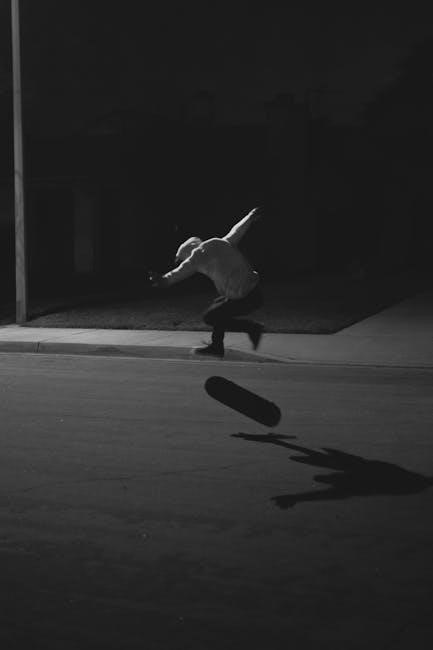Trick-or-treating etiquette involves polite behavior, such as saying “Trick or Treat” and thanking homeowners. Respect property and stay in groups for safety, ensuring a positive experience for everyone involved.
Understanding the Basics of Trick-or-Treating
Trick-or-treating is a beloved Halloween tradition where children dress in costumes and visit neighbors to collect candy and other treats. It typically begins at sunset and lasts until early evening, with younger children often finishing earlier. The activity involves approaching homes, ringing doorbells, and politely asking for treats using the phrase “Trick or Treat.” Safety is a priority, so children are encouraged to carry flashlights or wear glow-in-the-dark accessories for visibility. Staying in groups and having adult supervision are also key to ensuring a safe and enjoyable experience. Additionally, being mindful of homeowners’ property and respecting boundaries is part of the etiquette. Many communities also offer alternative trick-or-treating events in public spaces for added safety and convenience. This tradition fosters a sense of community and joy, making it a highlight of the Halloween season for families worldwide.

Historical Background of Halloween Traditions
Halloween traditions, including trick-or-treating, trace their roots to the ancient Celtic festival of Samhain. Celebrated on November 1st, Samhain marked the end of the harvest season and the beginning of winter, believed to be a time when the boundary between the living and the dead blurred. The Celts would light bonfires, wear costumes, and offer food to ward off spirits. As the Roman Empire and Christianity influenced the Celts, Samhain evolved into All Hallows’ Eve, later known as Halloween. The tradition of “souling,” where poor individuals would ask for food in exchange for praying for the dead, laid the groundwork for modern trick-or-treating. Over time, this practice transformed into a fun, community-based activity, especially in the United States, where children began visiting homes for candy and treats in the mid-20th century. This historical evolution has shaped the Halloween celebrations we know today.

Safety Tips for Trick-or-Treaters
Trick-or-treaters should carry flashlights or glow sticks for visibility and wear costumes that don’t obstruct vision or cause tripping hazards, ensuring a safe Halloween experience.
Importance of Visibility and Lighting
Visibility and lighting are crucial for trick-or-treaters to ensure safety while navigating neighborhoods at dusk or in the dark. Carrying flashlights, glow sticks, or wearing glow-in-the-dark accessories helps trick-or-treaters see their surroundings clearly and makes them more visible to drivers. Reflective costumes or accessories can also enhance visibility, reducing the risk of accidents. Proper lighting on sidewalks and driveways is essential, as it guides trick-or-treaters and helps them avoid potential hazards like uneven pavement or obstacles. Ensuring costumes do not obstruct vision or movement is equally important. Visibility and lighting not only protect trick-or-treaters but also provide peace of mind for parents and homeowners, fostering a safer and more enjoyable Halloween experience for everyone involved.
Staying in Groups and Supervision
Staying in groups and having adult supervision are essential for a safe and enjoyable trick-or-treating experience. Trick-or-treaters, especially younger children, should never venture out alone, as this increases the risk of accidents or getting lost. Walking in groups not only enhances safety but also allows for mutual assistance if someone trips or encounters an issue. Adults should accompany children to ensure they follow traffic rules, avoid unsafe homes, and stay within designated neighborhoods. Supervision also helps guide children in making responsible choices, such as not entering homes or accepting unwrapped treats. Older kids who trick-or-treat without adults should stay in well-lit, familiar areas and keep their parents informed of their whereabouts. Group outings foster camaraderie and help create lasting Halloween memories while prioritizing safety and accountability.

Etiquette for Trick-or-Treaters
Etiquette for trick-or-treaters includes being accommodating by offering allergen-free and regular treats, ensuring all children feel included. Homeowners should signal welcome with clear decorations, creating a positive experience for everyone.
Saying “Trick or Treat” Politely
Saying “Trick or Treat” politely is a cornerstone of Halloween etiquette. Children should clearly and cheerfully utter the phrase, ensuring it is audible and respectful. Accompanying the words with a smile and good manners enhances the experience for both trick-or-treaters and homeowners. It is also important to express gratitude, such as saying “thank you,” after receiving candy. Politeness fosters a positive interaction, making the tradition enjoyable for everyone involved. Encouraging children to practice their delivery beforehand can help build confidence and ensure a courteous approach. Remember, politeness is key to creating lasting impressions and maintaining the spirit of Halloween traditions.
Respecting Homeowners and Their Property
Respecting homeowners and their property is essential during trick-or-treating. Avoid damaging lawns, gardens, or decorations, and only approach houses with porch lights on, indicating they welcome trick-or-treaters. Never trespass or enter homes uninvited. Take only one piece of candy unless explicitly offered more, and refrain from touching or handling items on the porch. Respect any rules homeowners have set, such as specific trick-or-treat hours. Always thank the homeowner politely before leaving. By showing consideration for their property and generosity, trick-or-treaters help maintain a positive and enjoyable experience for everyone. Remember, respecting others’ space and belongings fosters goodwill and ensures the tradition remains a cherished part of Halloween celebrations.

Preparing for Trick-or-Treating
Ensure costumes are safe and visibility is maintained with flashlights or glow sticks. Carry sturdy bags or buckets for treats and inspect candy at home for safety.
Choosing the Right Costume

Choosing the right costume is essential for a fun and safe trick-or-treating experience. Opt for costumes that allow clear visibility and ease of movement. Avoid masks or headgear that obstruct vision, as this can pose safety risks, especially in low-light conditions. Ensure costumes are made from flame-resistant materials to prevent accidents. Weather-appropriate clothing, such as layers or rain gear, should be considered depending on the climate. Additionally, select costumes that align with cultural sensitivity and personal preferences. Comfort is key, as children will be walking and standing for extended periods. Finally, ensure the costume complements the ability to carry trick-or-treat bags or buckets securely. Proper preparation ensures a safe and enjoyable Halloween outing for all participants.
Carrying the right trick-or-treat bag or bucket is crucial for a successful Halloween outing. Opt for sturdy, lightweight containers with secure handles to ensure easy carrying. Reflective or glow-in-the-dark designs enhance visibility, making it safer for trick-or-treaters to navigate in the dark. Avoid overly large bags that may cause tripping or difficulty in walking. Consider using buckets or bags with lids to keep candy clean and dry. Additionally, ensure the container is easy to open and close, allowing quick access when receiving treats. Parents or guardians should supervise the handling of bags to prevent accidents and ensure candies are collected safely. Choosing the right bag or bucket not only adds to the festive spirit but also ensures a practical and enjoyable experience for all participants.

Cultural Significance of Trick-or-Treating
Carrying Trick-or-Treat Bags or Buckets
Trick-or-treat bags or buckets should be sturdy, lightweight, and easy to carry. Reflective or glow-in-the-dark designs improve visibility, ensuring safety while walking in the dark. Avoid overly large containers to prevent tripping and make sure handles are secure. Using buckets with lids can keep candy clean and dry. Parents should supervise to ensure bags are handled safely and treats are collected properly. The right bag enhances both practicality and the festive spirit, making the experience enjoyable for all trick-or-treaters.
Modern Traditions and Variations
Modern trick-or-treating has evolved with cultural and societal changes. Many communities now organize “Trunk-or-Treat” events, where children collect candy from decorated car trunks in a controlled environment. Some areas also host indoor trick-or-treating at malls or community centers, ensuring safety and accessibility. Additionally, there is a growing trend toward allergy-friendly treats, with homeowners offering non-food items or allergen-free options to accommodate children with dietary restrictions. Technology has also influenced the tradition, with apps helping families find participating homes or track routes. These variations reflect a blend of tradition and innovation, ensuring trick-or-treating remains enjoyable and inclusive for all participants while maintaining its festive spirit.
Impact on Local Communities
Trick-or-treating has a significant impact on local communities, fostering a sense of connection and camaraderie. It encourages neighbors to interact, creating a welcoming atmosphere for families and children. Many communities organize special events, such as trunk-or-treat gatherings or Halloween festivals, which draw people together and strengthen social bonds. Local businesses also benefit, as families purchase costumes, decorations, and candy, boosting seasonal sales. Additionally, some communities use trick-or-treating as an opportunity to promote safety initiatives, such as distributing reflective accessories or hosting workshops on pedestrian safety. Overall, trick-or-treating serves as a platform for community engagement, cultural exchange, and shared celebration, making it a cherished tradition that benefits both individuals and the collective whole.
